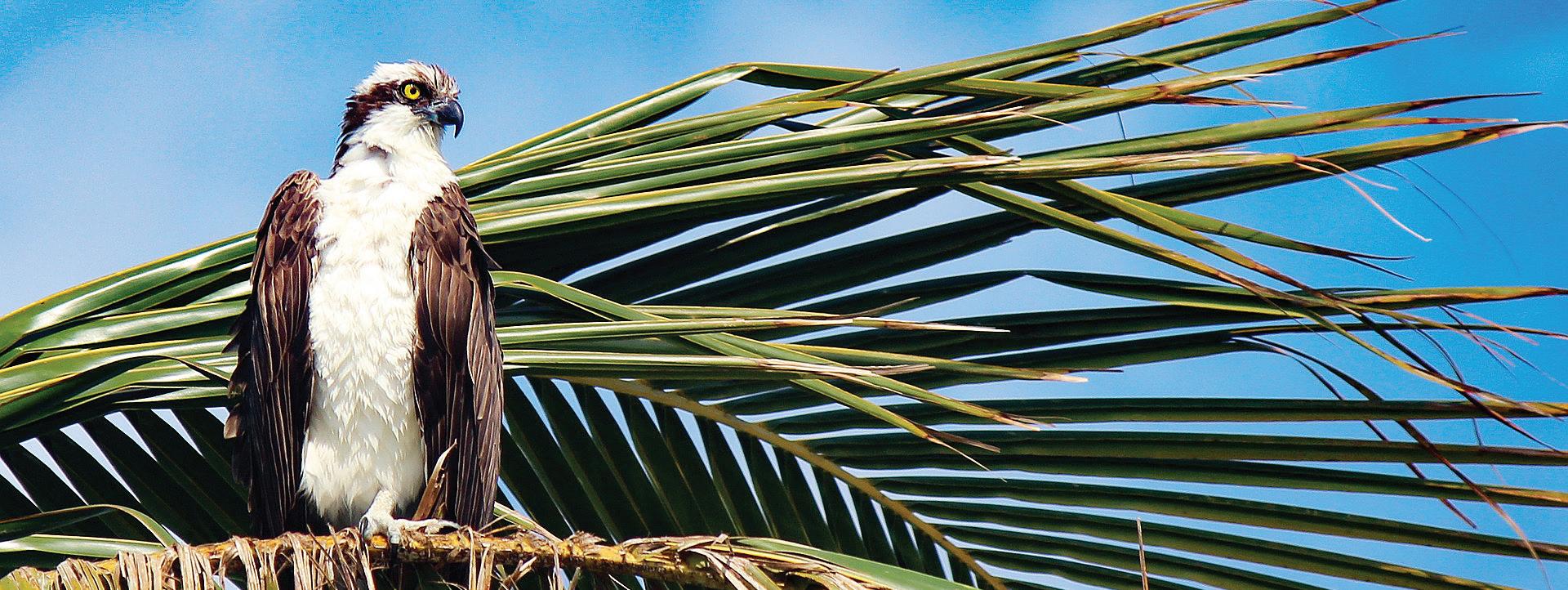
2 minute read
Ospreys: Local Raptors that Thrive
By Amanda Hagood
It sounds like a whistling kettle. A piping call that sends my eyes to the skyline, searching for the watchful guardian of the shoreline: the osprey. These sleek raptors, cousins to the bald eagle, can be seen all over Gulfport, loafing (yes, that is the scientific term) at the tops of trees, lamp posts, or even ships’ masts, slicing through the air with a cargo of fish (their primary food), or, during their breeding season (December-February), transporting sticks, moss or even netting to their nesting sites.
Advertisement
Though they are common, we should not take them for granted. As Beth Forys, Professor of Biology at Eckerd College, recently reminded me, it is rather unusual, and rather cool, to have so large a bird of prey living successfully in our midst.
Ospreys are built for fishing: plunging into water at up to 30 miles per hour, they can lower a goggle-like eyelid and seal their nostrils for complete submersion. As they ascend, they reverse their outer toes to position their catches aerodynamically headfirst. They can forage in both salt and fresh water, allowing them to try new fishing grounds, such as retention ponds, when algal blooms threaten other fish-eating birds. And that dark eyeline they sport? No known purpose, but doesn’t it look just like a racing stripe?
Ospreys’ most extraordinary adaptation is their willingness to nest in a variety of places, from dead trees, to utility poles, to chimneys and buoys. This is a key reason that osprey populations, unlike many raptors across the globe, are on the rise. This also leads to the occasional human-wildlife conflict. Forys recalled one season when ospreys began to nest in the outdoor lights at the campus ballfield, making it difficult to maintain the lights. Tampa Bay Raptor Rescue helped to solve the problem by installing nesting platforms above the lights. Now everyone can enjoy the game.
Ospreys, like Gulfportians, know a good place once they’ve found it. They will return for many years to a successful nesting site. Over the seasons, these somewhat disheveled domiciles can grow three to six feet wide. Following a nest during breeding season is a great way to get to know our remarkable feathered neighbors. We have several active nest sites in Gulfport, including some in Clam Bayou, behind Boca Ciega High School, and along 26th Avenue. You can find each of these in the crowd-sourced database known as Osprey Watch, osprey-watch. org.
More Birds of Prey at Home
Check out ospreys and more at Raptor Fest, an educational event that typically raises $10,000 for Boyd Hill’s Birds of Prey Program. For the first time, the event will be virtual, on Saturday, February 6, at 10 a.m at fb.com/stpeteparksrec.
Normally bringing an average of 5,000 attendees to Boyd Hill Nature Preserve, this year’s Raptor Fest @ Home will be a series of educational events, including ranger question-andanswer sessions.
The 20 non-releasable birds of prey that spend their days at the St. Petersburg preserve will be “adopted” through the park’s Adopt a Bird program and presented via live stream in recognition of the donors.
Visit raptorfest.org or call 727-893- 7326 for more.

Sue Chem









